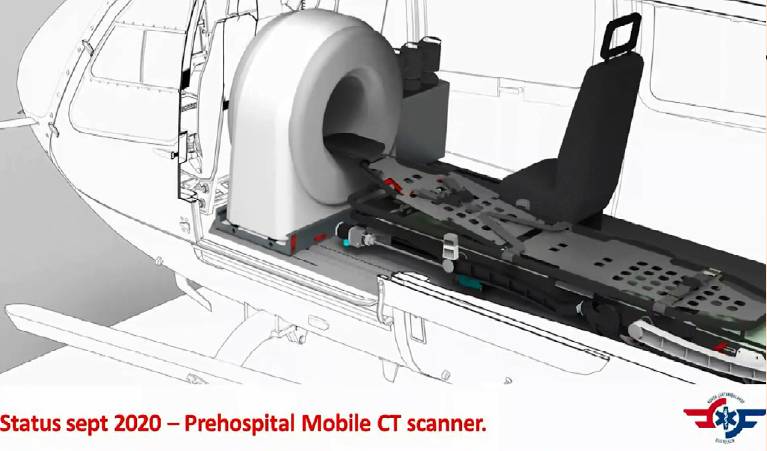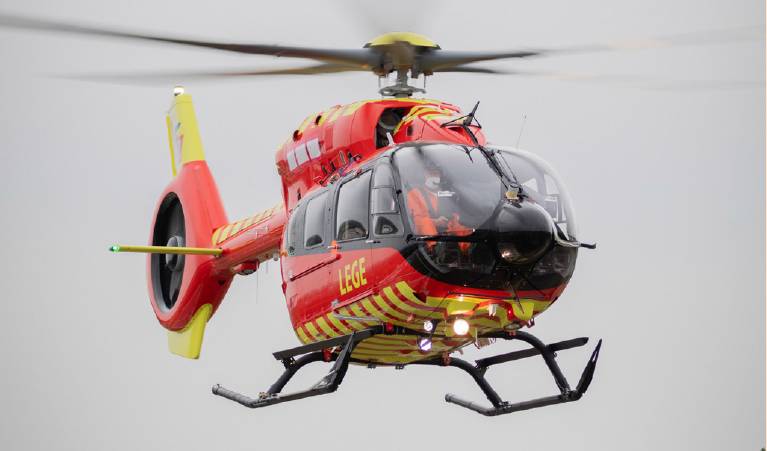GENERAL AVIATION Airbus H145
Norwegian Air Ambulance Foundation HEMS testbed
 On 30 September 2020, Airbus Helicopters announced the delivery of the first customer D-3 to the Stiftelsen Norsk Luftambulanse (Norwegian Air Ambulance Foundation). A subsidiary of the Foundation, Norsk Luftambulanse (Norwegian Air Ambulance) provides HEMS to the Luftambulansetjenesten, Norway’s national air ambulance service, and to Denmark. The D-3 will remain with the Foundation as a trials platform, a role HEMS pilot and Head of Flight Operations Development, Erik Normann, believes is unique.
On 30 September 2020, Airbus Helicopters announced the delivery of the first customer D-3 to the Stiftelsen Norsk Luftambulanse (Norwegian Air Ambulance Foundation). A subsidiary of the Foundation, Norsk Luftambulanse (Norwegian Air Ambulance) provides HEMS to the Luftambulansetjenesten, Norway’s national air ambulance service, and to Denmark. The D-3 will remain with the Foundation as a trials platform, a role HEMS pilot and Head of Flight Operations Development, Erik Normann, believes is unique.
 The Foundation has already caused much discussion and interest with its plan to install a cranial CAT scanner to give on-site assessments of trauma patients. Norwegian Air Ambulance“We have a large fleet of D-2s, so we knew what we were getting with the D-3,” Normann says. “The H145 is like a helicopter SUV, flexible and relatively small, but with a large cabin. If you need to land in tight spots, with range and payload, it provides a good compromise. The Helionix cockpit is also very flexible, really easy to use on a simple, short-range VFR flight but as advanced as any modern airliner cockpit for IFR in marginal conditions. The autopilot is fantastic too.”
The Foundation has already caused much discussion and interest with its plan to install a cranial CAT scanner to give on-site assessments of trauma patients. Norwegian Air Ambulance“We have a large fleet of D-2s, so we knew what we were getting with the D-3,” Normann says. “The H145 is like a helicopter SUV, flexible and relatively small, but with a large cabin. If you need to land in tight spots, with range and payload, it provides a good compromise. The Helionix cockpit is also very flexible, really easy to use on a simple, short-range VFR flight but as advanced as any modern airliner cockpit for IFR in marginal conditions. The autopilot is fantastic too.”
“The D-3 solved the operational challenges we faced with the D-2, which made it our ideal research platform. The aircraft’s greater payload was important but its improved ride quality was especially appealing. We’ve so far only flown the aircraft home – it is awaiting EASA paperwork for the medical interior – and it’ll be exciting to get out and fly it properly.”
 The Norwegian Air Ambulance Foundation took delivery of the first customer BK117D-3 at the end of September 2020. Its Norsk Luftambulanse subsidiary began operations using a BO 105 in 1978 and has remained faithful to the products of what became Airbus Helicopters ever since, although its current roster also includes the Leonardo AW139. Airbus Helicopters
The Norwegian Air Ambulance Foundation took delivery of the first customer BK117D-3 at the end of September 2020. Its Norsk Luftambulanse subsidiary began operations using a BO 105 in 1978 and has remained faithful to the products of what became Airbus Helicopters ever since, although its current roster also includes the Leonardo AW139. Airbus Helicopters
The medical fit is currently similar to that already established in service, avoiding the need to certify new equipment. Later, it will take on the test mission. “We’re already looking at transferring the human-machine interface and ergonomics that pilots have become accustomed to in modern cockpits into the back, where the information the medical team needs is on screens all over the place. It is true of all HEMS helicopters and we want to clean that up with a little bit of aviation philosophy; away off in the future, the doctor may have a helmet display showing all the information.”
The Foundation has already caused much excitement and discussion with its plan to install a head-only CAT scanner. “People think it’s crazy because these things are maybe 400 or 500kg and located in hospitals but we know there are real benefits if we can move stroke treatment from hospitals out to the patient. It’s been done experimentally with land ambulances and there will be even more benefit to using a helicopter but there are technical challenges to that and we’re working on them. Our plan is to show the D-3, with a CAT scanner installed as a working prototype, at Airmed 2022 in Salzburg.”